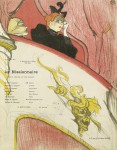 The Van Gogh Museum in Amsterdam first got into the French turn-of-the-century prints when it bought 800 exceptional examples from a German private collection in 2000. Since then the museum has made a point of acquiring more outstanding pieces. There are just under 1,800 French prints from 1890-1905 in the Van Gogh Museum now, but they are almost never displayed because light exposure is so dangerous to them. As of today, 1,739 French fin de siècle prints from the Van Gogh Museum’s collection have been uploaded to a dedicated website where we can see them but light cannot harm them.
The Van Gogh Museum in Amsterdam first got into the French turn-of-the-century prints when it bought 800 exceptional examples from a German private collection in 2000. Since then the museum has made a point of acquiring more outstanding pieces. There are just under 1,800 French prints from 1890-1905 in the Van Gogh Museum now, but they are almost never displayed because light exposure is so dangerous to them. As of today, 1,739 French fin de siècle prints from the Van Gogh Museum’s collection have been uploaded to a dedicated website where we can see them but light cannot harm them.
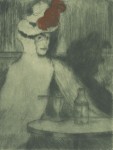 The reason the Van Gogh Museum has made a point of collecting French prints is that they’re very relevant to Vincent Van Gogh’s aesthetic, artistic interests and the milieu in which his art evolved. Printmaking really took off in France in the second half of the 19th century. Before then, prints were copies of well-known artworks, an inexpensive way to for the general public to have a faithful rendition of the Mona Lisa or Venus de Milo in their homes. Printmaking evolved into a valid artistic medium in its own right when French artists explored the possibilities of the form in a creative and engaging way. The Japonisme trend played a significant role in this shift, because the Japanese had such a rich tradition of artistic woodblock printing as evinced in the work of masters like Hokusai and Suzuki Harunobu.
The reason the Van Gogh Museum has made a point of collecting French prints is that they’re very relevant to Vincent Van Gogh’s aesthetic, artistic interests and the milieu in which his art evolved. Printmaking really took off in France in the second half of the 19th century. Before then, prints were copies of well-known artworks, an inexpensive way to for the general public to have a faithful rendition of the Mona Lisa or Venus de Milo in their homes. Printmaking evolved into a valid artistic medium in its own right when French artists explored the possibilities of the form in a creative and engaging way. The Japonisme trend played a significant role in this shift, because the Japanese had such a rich tradition of artistic woodblock printing as evinced in the work of masters like Hokusai and Suzuki Harunobu.
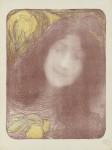 Many of the greatest artists of the second half of the 19th century had print collections and experimented with lithography and printmaking in their own work. Prints appeared in the public and private spaces of Paris as posters, magazines covers, menus, theater programs, sheet music and books. The medium allowed artists to get their work out there on a large scale, to cross-pollinate with other art forms and even to control the supply and demand of their own output by deliberately creating limited editions coveted by the buying public.
Many of the greatest artists of the second half of the 19th century had print collections and experimented with lithography and printmaking in their own work. Prints appeared in the public and private spaces of Paris as posters, magazines covers, menus, theater programs, sheet music and books. The medium allowed artists to get their work out there on a large scale, to cross-pollinate with other art forms and even to control the supply and demand of their own output by deliberately creating limited editions coveted by the buying public.
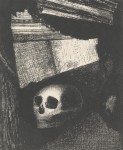 Vincent Van Gogh died in 1890, so most of the prints in the collection were made after his death when the rage for printmaking in France reached its apex, but he and his brother Theo followed closely the explosion of printmaking in the fin de siècle. Both collected prints from their friends and contemporaries. The Van Gogh Museum’s print collection begins where Vincent’s collection began and then moves forward connecting the next generation of artists to those who influenced them.
Vincent Van Gogh died in 1890, so most of the prints in the collection were made after his death when the rage for printmaking in France reached its apex, but he and his brother Theo followed closely the explosion of printmaking in the fin de siècle. Both collected prints from their friends and contemporaries. The Van Gogh Museum’s print collection begins where Vincent’s collection began and then moves forward connecting the next generation of artists to those who influenced them.
 Those connections are at the core of the Van Gogh Museum’s new online exhibition of the print collection. The French Printmaking homepage opens with a group of thumbnails. Click on one and take the plunge, or if you click on “Discover the prints” on the left side to get to a larger assembly of tiled prints. Those tiles of print thumbnails hover behind any individual print you chose to click on as well. Once you’ve clicked on one print, four themes appear at each corner that connect this print to others in the collection. Themes include the publisher, medium, technique, salient features of the print, subject, pattern, and on and on. The Van Gogh staff have assigned an astonishing 1,300 themes to the print collection, which makes it a browser’s paradise.
Those connections are at the core of the Van Gogh Museum’s new online exhibition of the print collection. The French Printmaking homepage opens with a group of thumbnails. Click on one and take the plunge, or if you click on “Discover the prints” on the left side to get to a larger assembly of tiled prints. Those tiles of print thumbnails hover behind any individual print you chose to click on as well. Once you’ve clicked on one print, four themes appear at each corner that connect this print to others in the collection. Themes include the publisher, medium, technique, salient features of the print, subject, pattern, and on and on. The Van Gogh staff have assigned an astonishing 1,300 themes to the print collection, which makes it a browser’s paradise.
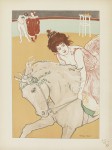 This approach gives a unique glimpse into the richness of the printmaking community of fin de siècle Paris. You can get an instant understanding of how artists shared the same printers, influenced each other in everything from the paper used to the visual motifs. When click on a print, you can see it’s stats, but there is no detailed paragraph or two explaining the setting, author, etc. that you might expect to find. Instead, the print and its contents are described by keywords, each of them hotlinks to more works in the collection that can also be described by those keywords.
This approach gives a unique glimpse into the richness of the printmaking community of fin de siècle Paris. You can get an instant understanding of how artists shared the same printers, influenced each other in everything from the paper used to the visual motifs. When click on a print, you can see it’s stats, but there is no detailed paragraph or two explaining the setting, author, etc. that you might expect to find. Instead, the print and its contents are described by keywords, each of them hotlinks to more works in the collection that can also be described by those keywords.
I like me some words, so I was glad to see more than a group of descriptors when I clicked on individual themes. They’re full of information, links to more information, even a list of resources for further reading on your own. It’s a marvelously flexible and user-friendly system and so very highly conducive to lost weekending. And oh, the resolution. The beautiful, perfect, gloriously high resolution. It makes me feel kinda funny, like when we used to climb the rope in gym class.